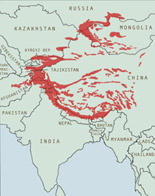How many snow leopards survive in Tajikistan?
 The most recent information available from the Snow Leopard Survival Strategy 2014 suggests the total habitat area for snow leopards in Tajikistan is about 85,700 km, which represents 60% of the total territory of the country. According to local experts there are approximately 250 to 280 snow leopards. However there are significant threats to snow leopards in Tajikistan including loss of prey, poaching, lack of awareness among decision makers and local population on importance of snow leopard conservation and poor implementation of legislation which protects snow leopards and other endangered wildlife in the country.
The most recent information available from the Snow Leopard Survival Strategy 2014 suggests the total habitat area for snow leopards in Tajikistan is about 85,700 km, which represents 60% of the total territory of the country. According to local experts there are approximately 250 to 280 snow leopards. However there are significant threats to snow leopards in Tajikistan including loss of prey, poaching, lack of awareness among decision makers and local population on importance of snow leopard conservation and poor implementation of legislation which protects snow leopards and other endangered wildlife in the country.
Tajikistan is a mountainous country in Central Asia with borders to Afghanistan in the south, Uzbekistan to the west, Kygyzstan to the north and China to the east. Mountains cover over 90% of this country.
Snow Leopard Habitat
The total area of protected regions in Tajikistan is 3.1 million hectares which is about one fifth of the entire country. The Tajik National Park is believed to be home to about 140 snow leopards, that is about two thirds of all the snow leopards in the country.
Tajikistan became a republic of the Soviet Union known as the Tajik Soviet Socialist Republic in 1929. After the collapse of the Soviet Union in 1900 and after its independence, Tajikistan suffered a devastating civil war from 1992 to 1997. Since the end of the war, with political stability and foreign aid the country’s economy has grown, although World Bank figures suggest that in 2005 more than half of the population was living below the poverty line on less than $2.15 a day.
With such extreme poverty it is not surprising that illegal hunting for meat and trophies is depleting snow leopard prey populations. Livestock grazing also destroys the grasslands, and overgrazing decreases the food supply for the wild sheep and goats that are the snow leopard’s main prey.
In the last decade more villagers and herders have pushed into mountainous areas with their livestock and as a result, the snow leopard’s habitat has degraded and fragmented. As in other range countries there is also conflict with local people, when snow leopards kill domestic livestock when their natural prey is scarce.
 Flora and Fauna International is a conservation NGO working to save what remains of the country’s rich natural heritage including Zorkul lake Zapovednik and the surrounding Pamir Mountains. The Pamirs, known as the ‘Roof of the World’, are one of the key mountain ranges of Central Asia and are home to Tajikistan’s significant snow leopard population. FFI is working to bring together local communities, hunting agencies, the state conservation sector and the military on the Tajik side of the Pamir mountain range in a program to help conserve wildlife.
Flora and Fauna International is a conservation NGO working to save what remains of the country’s rich natural heritage including Zorkul lake Zapovednik and the surrounding Pamir Mountains. The Pamirs, known as the ‘Roof of the World’, are one of the key mountain ranges of Central Asia and are home to Tajikistan’s significant snow leopard population. FFI is working to bring together local communities, hunting agencies, the state conservation sector and the military on the Tajik side of the Pamir mountain range in a program to help conserve wildlife.
The Snow Leopard Conservancy’s (SLC) Rodney Jackson conducted a visit to Tajikistan in 2003, examining approaches for promoting wildlife conservation and community-based monitoring in the eastern Pamir mountains. He trained local staff and herders in basic survey methods for monitoring snow leopard and Marco Polo sheep. Since then the SLC with continued funding from The Christensen Fund, has implemented a number of community-driven activities to foster the stewardship of biological diversity and wildlife conservation in tandem with the development of sustainable livelihoods for local people. More news on how Tajikistan is working on snow leopard conservation.
Panthera, the global wild cat conservation NGO has supported the creation of a Tajik Snow Leopard Action Plan, finalised in December 2009. Panthera is also collaborating with the Institute of Zoology within the Tajik Academy of Sciences to conduct snow leopard surveys in the Pamir Mountains. The Pamirs can provide an important link between the southern and northern range of snow leopards whose habitat is largely fragmented by human cities and settlement. Corridors where snow leopards can cross from one region to the other are vital to help in the genetic diversity of the species. Panthera’s role in Tajikistan has included training biologists and supporting snow leopard and key prey species surveys to identify numbers.
Panthera also partners the Committee for Environmental Protection under the Republic of Tajikistan
Panthera Vice President, Dr. George Schaller assisted in much of this work. Read more on Panthera’s work in Tajikistan.
Tajikistan has been taking part in the Global Snow Leopard and Eco-System protection program Global Snow Leopard and Eco-system Protection Program.





